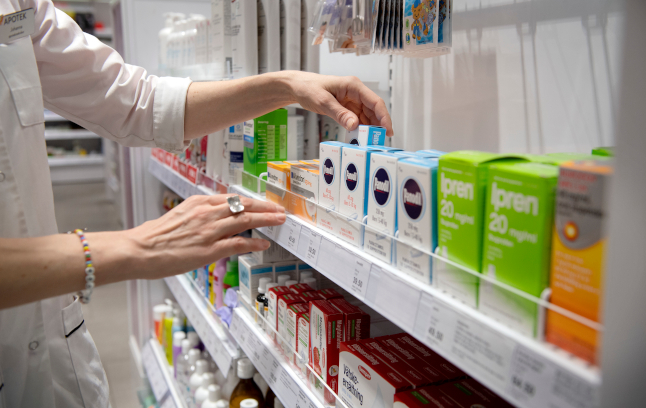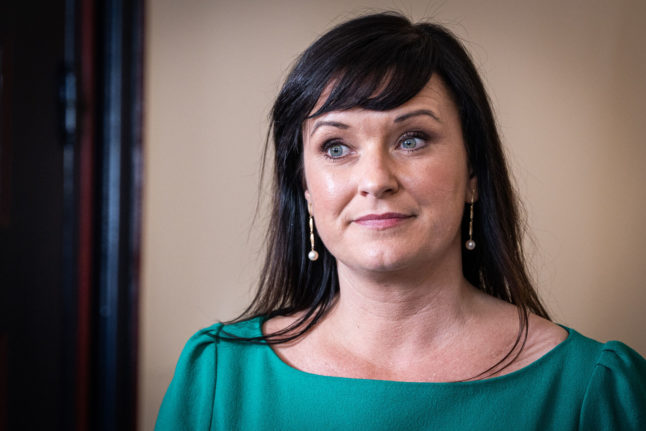What can I get over-the-counter (without a prescription)?
Herbal remedies, food supplements, and lower-dose painkillers are all available without a prescription. Some of them you can buy at regular grocery stores such as Ica or Coop, but pharmacies usually have a wider selection. Stronger drugs require a prescription.
How do you get a prescription?
You make an appointment with a doctor. Some district nurses and dentists can also write prescriptions. If you have a Swedish social security number, personnummer, and digital identification tool BankID, you can in some regions send a request to renew a prescription online.
Prescription in Swedish is recept. Google Translate might sometimes mistakenly translate this to “recipe”, because in Swedish it’s the same word.
Since 2017, all prescriptions are electronic, so you won’t get a piece of paper as long as you have a personnummer. All you need to do when you get to the pharmacy is show your ID card and they can see all the prescriptions you have.
If you don’t have a personummer, you’ll still able to be prescribed medicine in Sweden, it will just be issued on paper instead. Your coordination number or date of birth must be stated instead.
A prescription is valid for one year from the date of issue, unless a shorter period is specified.
Where can I get my medicine?
Only an official pharmacy (apotek in Swedish) can sell prescription medicine. There are lots of pharmacy chains in Sweden, since they were de-regulated in 2009. Only official pharmacies are allowed to use the green cross; the global symbol for pharmacy.
Apoteket is the last remaining state-owned pharmacy and also the largest. There’s also Hjärtat, which is owned by Ica, and Kronans Apotek.
While the cost of non-medical products may vary depending on the pharmacy, the cost of medicines is regulated so that it’s the same no matter which pharmacy you go to. You don’t need to always go to the same pharmacy either. Your medical history is recorded with your personnummer and each pharmacy can access it to see how much medicine you’ve received.
How much does medicine cost in Sweden?
Sweden has among the lowest prices in Europe for pharmaceutical products.
All medicines have different costs. But there is something called the high-cost protection (Högkostnadsskydd) which means that you don’t have to pay more than 2,350 kronor per year for prescription medicine if they are included in the drug benefit.
It works gradually. You pay the full price for medicine until it reaches 1,175 kronor in under a year, after which you gradually pay less and less of the cost.
- Between 1,175 and 2,243 kronor you pay 50 percent of the cost
- Between 2,244 and 4,167 kronor you pay 25 percent of the cost
- Between 4,168 and 5,767 kronor you pay 10 percent of the cost
When your total bill over the course of a year adds up to 2,350 kronor after all discounts have been deducted, you will receive a card which means that all the rest of your prescription medicine is now free for the rest of the year. After that year you’ll start paying again.
For people under the age of 18, prescription medicine is free.
The vast majority of all prescription drugs are covered by this high-cost protection. You can find exactly what is covered on the Swedish Dental and Pharmaceutical Benefits Agency (TLV) website which decides on cost and availability of medication.
If you are an EU, EEA or Swiss citizen, you pay the same subsidised fees as a Swedish citizen, but if you’re from another country you will in most cases have to pay the full cost of your care.
What’s the cheapest way to get the medicine I need?
The medicine that is suggested by the pharmacist first is always the one that is included in the drug benefit and which means it’ll be the cheapest.
Pharmacies are obliged to offer the cheapest medicine on the market, with the same active ingredient that the doctor stated on the prescription, so you might get different manufacturers if you go back to get the same medicine.
There’s a system which determines a “ceiling price” (takpriser) so that no one has to pay more than necessary for medicines. TLV determines the price of medicine and appoints which brand is cheapest for the month. As well as this, the state subsidises medicines for consumers.
Medicines that have been on the market for 15 years are cheaper.
What if I want a specific brand of drug?
You’ll always be offered the lowest price which means you’ll get the same medicine but from different manufacturers every time you pick up your medicine.
If, for some reason, you don’t want the cheapest medicine on the market, but the medicine listed on the prescription, then you can. But then you have to pay for a possible additional cost. The extra cost is not included in your high-cost protection.
Does an overseas prescription count?
If you have a prescription from an EU/EEA doctor it should work in a Swedish pharmacy. You’ll need the original paper prescription which needs to include your date of birth and be signed by a doctor. The address of the prescriber’s workplace and complete contact details must be included. Photocopies or printouts don’t qualify.
If your prescription is from outside the EU then you’re better off making an appointment to renew a prescription with a doctor in Sweden. You can do this via 1177.se or an online service such as Kry or doktor.se. If you don’t have a BankID or personnummer, then call a health centre (vårdcentral) directly.
Can I bring my medicines into Sweden?
You can take your medicines with you as long as you can prove that they’re for your own personal use (or your accompanying pet), and you need them for medical reasons.
Stricter rules apply to medicinal products containing narcotic or doping substances.
If you travel from a country within the EEA you are allowed to bring one year supply of medicines. If you’re coming from outside the EEA, you’re only allowed to bring three months’ supply of medicine.
There’s more information on the Swedish Medical Products Agency website in English.



 Please whitelist us to continue reading.
Please whitelist us to continue reading.
Member comments